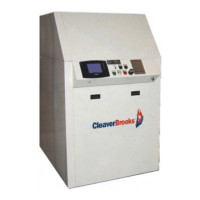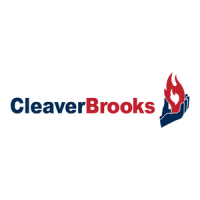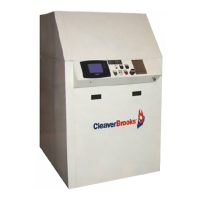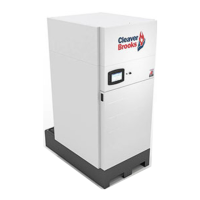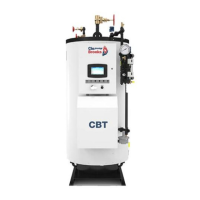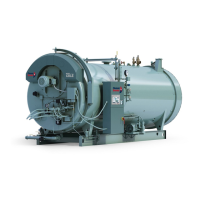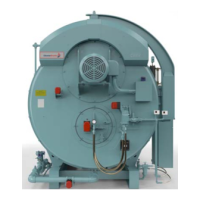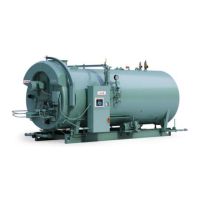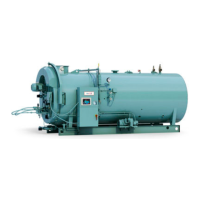CB FALCON
750-265 72
LEAD LAG
Falcon devices contain the ability to be a stand-alone control,
operate as a Lead Lag Master control (which also uses the
Falcon control function as one of the slaves), or to operate
solely as a slave to the lead lag system.
Falcon devices utilize two Modbus ports (MB1 and MB2) for
communications. One port is designated to support a system
display and the other port supports communications from the
LL Master with its slaves. Fig. 28 shows a simplified wiring
diagram connecting the system display with a 4 system Lead
Lag arrangement.
The Lead Lag master is a software service that is hosted by a
Falcon control. It is not a part of that control, but is an entity
that is “above” all of the individual Falcon controls (including
the one that hosts it). The Lead Lag master sees the controls
as a set of Modbus devices, each having certain registers, and
in this regard it is entirely a communications bus device, talking
to the slave Falcon controls via Modbus.
The LL master uses a few of the host Falcon's sensors (header
temperature and outdoor temperature) and also the STAT
electrical inputs in a configurable way, to provide control
information.
Lead Lag (LL) Master General
Operation
The LL master coordinates the firing of its slave units. To do
this it adds and drops stages to meet changes in load, and it
sends firing rate commands to those that are firing.
The LL master turns the first stage on and eventually turns the
last stage off using the same criteria as for any modulation
control loop:
• When the operating point reaches the Setpoint minus the
On hysteresis, then the first Falcon is turned on.
• When the operating point reaches the Setpoint plus the Off
hysteresis then the last slave Falcon (or all slave units) are
turned off.
The LL master PID operates using a percent rate: 0% is a
request for no heat at all, and 100% means firing at the
maximum modulation rate.
The LL master may be aware of slave’s minimum firing rate
and use this information for some of its algorithms, but when
apportioning rate it may also assign rates that are less than
this. In fact, the add-stage and drop-stage algorithms may
assume this and be defined in terms of theoretical rates that
are possibly lower than the actual minimum rate of the Falcon
control. A unit that is firing and is being commanded to fire at
less than its minimum modulation rate will operate at its
minimum rate: this is a standard behavior for a Falcon control
in stand-alone (non-slave) mode.
If any slave under LL Master control is in a Run-Limited
condition, then for some algorithms the LL master can
apportion to that stage the rate that it is actually firing at.
Additionally when a slave imposes its own Run-limited rate,
this may trigger the LL Master to add a stage, if it needs more
capacity, or drop a stage if the run-limiting is providing too
much heat (for example if a stage is running at a higher-than
commanded rate due to anti-condensation).
By adjusting the parameters in an extreme way it is possible to
define add-stage and drop-stage conditions that overlap or
even cross over each other. Certainly it is incorrect to do this,
and it would take a very deliberate and non-accidental act to
accomplish it. But there are two points in this:
1. LL master does not prevent it, and more important;
2. it will not confuse the LL master because it is imple-
mented as a state machine that is in only one state at a
time;
for example:
— if its add-stage action has been triggered, it will remain
in this condition until either a stage has been added,
or
— the criteria for its being in an add-stage condition is no
longer met; only then will it take another look around to
see what state it should go to next.
Assumptions
Modulating stage The modulating stage is the Falcon that is
receiving varying firing rate requests to track the load.
First stage This is the Falcon that was turned on first, when no
slaves were firing.
Previous stage The Falcon that was added to those stages
that are firing Just prior to the adding of the Falcon that is
under discussion.
Next stage The Falcon that will or might be added as the next
one to fire.
Last stage The Falcon that is firing and that was added the
most recently to the group of slaves that are firing. Typically
this is also the modulating stage, however as the load
decreases then the last-added stage will be at its minimum rate
and the previous stage will be modulating.
Lead boiler The Lead boiler is the Falcon that is the first stage
to fire among those stages which are in the equalize runtime
(Lead/Lag) group. If a boiler is in the “Use first” group it may
fire before the Lead boiler fires.
First boiler A Falcon may be assigned to any of three groups:
“Use First”, “Equalize Runtime”, or “Use Last”. If one or more
Falcons are in the “Use First” category, then one of these (the
one with the lowest sequence number) will always be the first
boiler to fire. If there is no Falcon in the “Use First” category
and one or more are in the “Equalize Runtime” category, then
the First boiler is also the Lead boiler.
